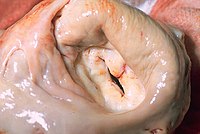
Photo from wikipedia
The management of mitral valve dysfunction in the setting of substantial mitral annular calcification (MAC) remains controversial and is one of the most challenging problems in mitral valve surgery. The… Click to show full abstract
The management of mitral valve dysfunction in the setting of substantial mitral annular calcification (MAC) remains controversial and is one of the most challenging problems in mitral valve surgery. The physiopathology of severe MAC is related to a combination of progressive, degenerative and active calcium deposition in the annulus that is often multifactorial, but largely attributable to aging and chronic disease conditions. Given the fact that overall life expectancy in the elderly population are increasing, it is imperative to understand contemporary and future therapeutic options since this MAC is likely going to be a frequent problem faced by the next generation of cardiac surgeons. This review provides a relevant synthesis of existing literature and aims to assess the efficacy of existing therapeutic choices for patients with mitral valve dysfunction and ‘big' MAC with a goal of minimizing postoperative complications (e.g. left ventricular outflow tract obstruction, prosthetic paravalvular leak, valve embolization, and stroke) that can be achieved via a multidisciplinary heart team approach.
Journal Title: Seminars in thoracic and cardiovascular surgery
Year Published: 2020
Link to full text (if available)
Share on Social Media: Sign Up to like & get
recommendations!